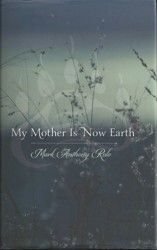Article Origin
Volume
Issue
Year
Poetic tale of a life of hardship
My Mother Is Now Earth
Mark Anthony Rolo
Borealis Books 2012
Reviewed by Shari Narine
In My Mother Is Now Earth, Mark Anthony Rolo tells the heart-wrenching story of the last three years of his childhood, which coincides with the last three years of his mother’s life. In the way only a young child can view events and people, Rolo is stark in the presentation of his family: his Ojibwe mother, who even in her wedding picture is looking away; his drunk white father, who Rolo refers to as “the old man,” until his mother’s death; his older brothers, whom he both idolizes and criticizes; his only sister Philly, who pushes him away and then clings to him at the time of their mother’s passing; and his younger brothers, who he argues with and then tends when he is thrown in to the role of caregiver.
The autobiography begins with the majority of the Rolo family, including dog Whiskey, making the trip from Milwaukee to Big Falls, Minnesota in the dead of winter in the father’s Oldsmobile in 1971. The Rolo family has been uprooted by a fire and are on their way to a farm, where the house is uninhabitable, because of a fire. For the winter, they live in the garage.
What unfolds is continued hardship. Don Rolo, the family patriarch, is full of big plans – chickens and cows and a farm that can provide for the whole family. But Don’s drinking colours those plans, leaves his wife Corinne and his children on edge. In the end, though, Don does realize his goal. His family is much smaller than when he arrived, the oldest boys moved out, Philly and the youngest son in foster care. Don makes his final payment on the farm four years after Corinne’s death and immediately puts the farm up for sale.
To her death, Corinne Rolo remains a mystery to the young Mark. He is scared of her and the long-handled broom she uses to mete out punishment and he craves her affection. Corinne is always writing letters “to the sisters,” her three sisters who remained behind in Milwaukee. But she carefully edits her letters. She exudes strength and dignity, but in return gives up the ability to present love openly.
In the summer of Rolo’s tenth year, he goes off to camp. When he returns home, he finds his mother sick. Shortly after that she dies on the operating table. It is her return to him in a dream in 2010 that prompts him to write his memoir.
My Mother Is Now Earth is full of nuances as Rolo stays true to his childhood self, understanding only what a pre-teen can, but in some of those moments his understanding is brilliant, like when he refers to the letters Corinne receives: “we know she likes to think about what’s in the letter, sometimes more than actually reading.” And in this same adolescent way, Rolo is harshly judgmental of his brothers and father, yet soft toward his mother, his fear of her as palpable as his need for her.
The young Rolo must not only navigate the world of his family but he must also navigate the wider world around him. He is an Indian, and although he knows very little of his culture (his mother shares almost nothing of her people’s ways), his Grade 5 teacher forces him to watch the news and orders him to make an oral presentation on the Indian standoff in South Dakota.
My Mother Is Now Earth is beautifully written. It paints the picture of a bleak, wintery landscape yet adds hope with such descriptions as “warm winds return as the winter weakens, drips away from the skies.” This is the same picture that can be painted of Rolo’s life. Although the young Rolo struggled in grade school, today he has a university degree and is a journalist, author and storyteller. He is also an enrolled member in his mother’s band, the Bad River Band of Ojibwe of Wisconsin.
- 1989 views

